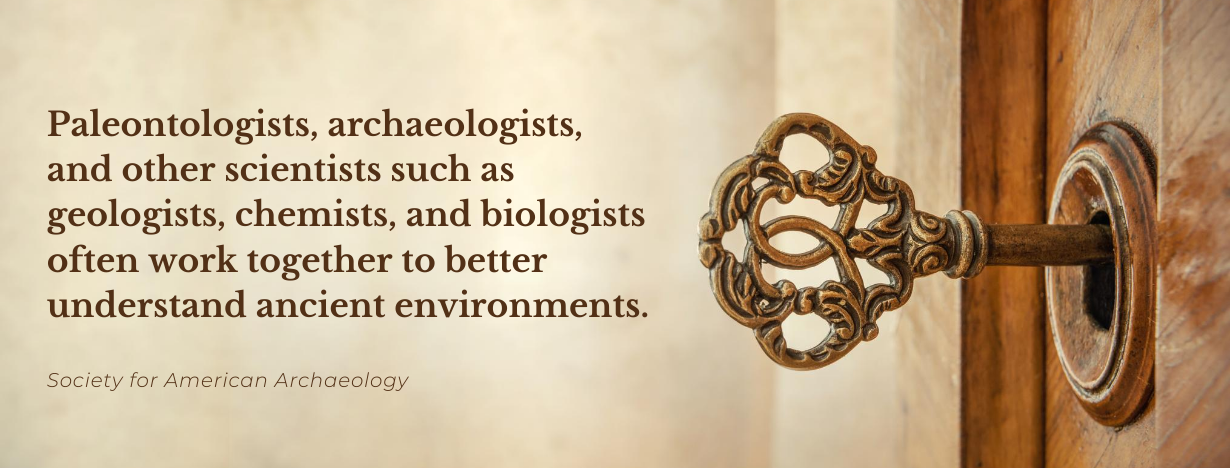Top 6 College Degrees That Dig Up the Past! Archaeology and Beyond!
Find your perfect college degree
Have you ever wondered what people who dig up the past do? When you think about archaeology, you may often coin it with long days, hot sun, high mounds, dark caves, or hard manual labor.
From uncovering palaces, graves, and houses to finding broken bits and pieces of metal or pottery or even unusual and glamorous objects that nobody has seen since the very last time they were used, all these are part of the life of an archaeologist.

Could this be the life in store for you? To have a full grasp of the idea, here are some answers to basic questions most incoming college students often ask when they wish to learn more about a career in digging up the past.
Degree in Archaeology
What is Archaeology?
Known as the study of human behavior in the past, Archaeology involves a careful study and analysis of material objects or remains through a systematic recovery.
Often called artifacts, these objects can be as massive as a building or as tiny as a button. Whether massive or not, these artifacts are evidence of past cultures and are our physical connection to the yesteryears.
This field is divided into the prehistoric and historical eras. Prehistoric archaeology deals with culture without a written language, during which people did not write anything about their culture. However, they left crucial remains like pottery, tools, dietary refuse, or ceremonial objects.
Historical archaeology, on the other hand, studies records like census, diaries, court or tax records, maps, photographs, deeds, and the like. With the use of these physical shreds of evidence, hand in hand with careful documentation, archaeologists can fully understand the past and the human behavior and culture back then.
How Important is Archaeology?
The primary goal of this field of study is to understand better why and how human behavior has changed over the years. Scientists look for evolution patterns that are critical in cultural events like the birth of new cities, the development of farming, or even the downfall of civilizations.
Archaeologists will try to search for helpful clues on why events like these occurred. Eventually, archaeologists are there to find possible ways to predict further how cultures will change and how to come up with a plan for the future.
When you say dig, do you literally dig?
In archaeology, ‘digging’ is not just an expression. When you are out for a dig, then expect to do just that! First and foremost, archaeology is manual labor.
You dig to remove dirt so you can tell how things came to be situated as they were. You are there so you can record this critical information and reconstruct what happened back then. You dig because your goal is to find out the context of every find.
When you know the context of your find, it gives you a whole perspective in understanding it. For instance, how do you interpret the use and meaning of an old hunting knife if you found it in a grave versus in a temple?
Actual digging is tedious and tiring. You break up dirt using pick-axes, shovel this dirt into buckets, and finally, haul it away using a wheelbarrow. By the time you find something, you then utilize smaller tools like whisk brooms, small picks, dustpans, trowels, and even dental picks or toothbrushes.
There is a constant back-and-forth process: from hard digging using extensive tools and then transitioning to slow and careful cleaning. Archaeologists must have the proper physical condition and ample stamina for them to bend and move around quickly.
How do these “digs” happen? And how long do they usually last?
Archaeologists do excavations anywhere in the world, from tropical jungles to big and modern cities and even in the Arctic.
Digging will depend on several factors, like local weather conditions, academic calendars, or national holidays. Knowing that these factors vary substantially all across the globe, it’s safe to say that on any given day, you can find archaeologists digging somewhere.
The process of digging is very taxing and very slow. In most cases, digging sites are big. Thus, it will take a lot of seasons before it gets completed. Typically, a single season lasts anywhere between a week and a few months. Excavations taking longer than that is very rare.
However, some projects can last for several years; for example, the Agora of Ancient Athens excavation started way back in 1931 or the Pompeii excavation which commenced in 1748. The best part of these long-term projects is that there will always be a handful of areas left un-excavated.
Leaving untouched areas is very important as this can give future archaeologists a turn to excavate. Plus, the newer breed of these scientists is expected to have more knowledge and better techniques.
Fun Fact: Did You Know?
Did you know that archaeologists dig holes with square forms? They usually dig square holes which are perfectly formed on a grid system. However, this is not simply because they prefer the style or shape; it entails a reason behind it. This is because they can conduct records and keep track of what they can find, all in a more organized manner. When they bring back their discoveries in the laboratory, they can sort it all through by formulating a map. Such a strategy will help them understand how life was lived during that era.
How does a typical digging day work?
On an ordinary working day, archaeologists wake up as early as 5 in the morning for two reasons. First is the day’s weather. Working outside in the afternoon is very hot. Thus, starting as early as the break of dawn gives them enough time to put up a good day’s work by noontime.
Second is the stretch of work. Archaeologists usually start early in the morning and take some rest during noontime. By mid-afternoon, they go back to their business, digging once again for another round.
Afternoon work consists typically of studying, cleaning, or writing information about the artifacts found in the morning. This usually stretches until dinner time. Projects run on a six-day workweek.
Excavations are somewhat dangerous because of the potential hazards. Usual challenges frequently result in insect bites, sunstroke, sunburn, or dehydration because of prolonged exposure outdoors. Blisters, injuries from rocks or tools, or even falling into the excavation site also pose critical concerns.
How is the past examined?
Archaeological sites are proof of human activities usually associated with artifacts. Excavating these sites is a destructive method that requires the systematic removal of artifacts and soils. Archaeological sites are somewhat similar to research laboratories where data is gathered, recorded, and studied.
Mapping of information from a controlled excavation allows scientists to look for patterns in past human behavior. These patterns are then examined to check changes in human behavior for more extended periods.
Will I need to travel to be an Archeologist?
Yes, where you travel as an archeologist will depend on your research interests and the field of archeology you specialize in as you conduct research and excavations. Most likely, you will need to travel to different locales and countries.
The most popular location for archeologists today is probably the Middle East, which has hosted some of the world’s most important archaeological discoveries in recent years.
Besides the Middle East, the most popular location for archeologists today also includes exploring sites in the Mediterranean, North Africa, and South and Central America.
In the past years, archaeology has quietly revolutionized its practices. Archaeologists today can virtually see through the ground without the need to dig. Soil chemistry, coupled with advancements in geophysics, has significantly sped up the discovery of ancient sites. This has dramatically helped archaeologists understand a specific study on a global scale.
Below are some of the most helpful modern-day tools and techniques that have revolutionized how scientists dig up the past:
- Google Earth. This satellite imagery tool has made it possible for researchers to zoom into even the most remote of sites anywhere in the world. It is now effortless to spot things like enclosures or settlement mounds, even when you’re halfway across the world. Back in the day, aerial photographs were utilized, but they were tough to access.
- LIDAR. Archaeological sites have surface traces of what lies beneath the soil. During the past decades, archaeologists have manually labored in mapping humps and bumps with the use of hachures. Today, LIDAR (Light Detection and Ranging) technology can produce a very detailed 3D map of the surface of the Earth within a fraction of a time.
- Drones. Drones have been used by archaeologists for quite some time already. Back then, scientists had to rely on homemade kits, model planes, and even helium balloons in a bid to fill the gap between images taken on top of shaky ladders and aerial photographs. Today, drones can snap photos in frost, in low light, and even in snowy conditions.
- Shallow Geophysics. Geophysical methods can help pinpoint targets to investigate. However, the process is prolonged. But in recent years, sensitive magnetometers equipped with multiple sensors secured on a car and linked to a GPS were utilized. This can survey massive land areas in real-time and can show an entire landscape without the scientist having to be physically present onsite.
- Soil Geochemistry. Traces of feces from both animals and humans during ancient times can stay in the soil for years. When patterns are studied and recorded, it is highly probable to locate these ancient sites. But the process is very tedious. Thankfully, portable X-ray fluorescence spectroscopy measurements became readily available. This works by emitting X-rays that the sample atoms absorb.
Schools Offering Archaeology Programs
Archaeology programs are available at four-year US Colleges and universities. The degree covers the theoretical and practical knowledge needed to become an archaeologist. Generally, a degree program in archaeology gears a student to work in laboratories and the field.
Here are the top US schools that offer archaeology programs or concentrations:
Brigham Young University
New York University
University of Akron
University of North Carolina
Boston University
While archaeology is the most common degree related to digging up the past, several disciplines do the same.
Degree in History
History major study about the past. They learn about the different cultures of different societies and the cause of historical changes. History degree students study medieval England, ancient Egypt, modern America, and imperial China.
Some history programs also allow the student to explore and understand more about the history of medicine, technology, science, art history, or military history.
History students also learn and gain valuable skills for different career paths. And since this discipline calls for exceptional analytical and critical thinking and impeccable writing skills, history majors can quickly pursue careers in education, the legal field, or business.
Some graduates in history can also secure jobs in museums, libraries, or archives. They can even help in the preservation of historical artifacts and documents that allow others to learn more about the past.
Here are the top US schools that offer undergraduate history majors.
Columbia University
Harvard University
Princeton University
Stanford University
University of California- Berkeley
University of California- Los Angeles
University of Michigan-Ann Arbor
University of Pennsylvania
Yale University
Scholarships Offered For History Majors:
If you’re interested in studying an undergraduate program under a financial aid program, you may consider the following scholarship offerings:
Scholarships of up to $2,500 are awarded to two outstanding students who are enrolled full-time in an accredited college or university in the United States and are working on a degree in historic preservation. Several hundred dollars from the sale of the Centennial Pin go towards this scholarship.
These scholarship programs are designed for students studying arts or history. Applicants must be full-time enrolled in an accredited four-year institution at the time of application, reside in the United States, and have a 2.5 GPA. Essays and transcripts are required for entry.
Degree Programs and Majors in Criminal Science (Forensic Science)
In the US, no degree programs in criminal science are offered. However, students who are interested in this discipline can go for a degree program in forensic science that is offered at the bachelor’s or master’s degree level.

The bachelor’s degree program in forensic science focuses on the science used in criminal investigations. Students need to complete courses in forensic psychology, evidence gathering, court procedure, or toxicology.
Courses in biology, physics, and chemistry make up most of the curriculum in this discipline.
It takes four years to complete the program. The curriculum also consists of introductory and advanced courses, including:
- Forensic techniques
- Criminal procedures
- Forensic psychology
- Criminal courts
- Toxicology
- Pharmacology
Is Forensic Science the same as Criminology?
They are closely related, but forensic science and criminology are two different fields. Criminology deals with the study of crime, while forensic science focuses more on evidence.
Below are some of the US schools that offer some of the best programs in this discipline.
Mercyhurst University
University of Central Florida
Texas A&M University-College Station
Pennsylvania State University
University of Nebraska- Lincoln
Indiana University-Purdue University- Indianapolis
Cedarville University
Loyola University Chicago
Ohio Northern University
Madonna University
Degree in Geography
If you’re planning to pursue a geography degree, expect to learn a myriad of things. From urban development to climate variability, emerging infectious diseases to deforestation, a degree in geography covers a lot of issues.
As you scout for a geography program, think about the area of concentration and consider the courses. Some students are interested in studying naturally occurring structures and landforms, while others learn about resource availability and political boundaries. Like most bachelor’s degrees, a degree in geography will take you about four years.
Area of Concentration in Geography
Geography has a lot of subtopics. This means that there is no standard geography curriculum. Most programs of geography need some variation of the research project, internship, or fieldwork before you graduate.
The details vary a lot, so it’s wise to choose a program with an area of concentration that suits your future career plans.
- Physical Geography. This is where you track and study water, climate, landforms, organic life, and other natural phenomena. In this discipline, you get to examine why specific biological and physical processes occur.
- Geographic Information Systems. This field teaches students to use and gather geographical data. Enrollees investigate and discover spatial trends. They can also predict specific geographical systems like sea-level rise.
- Environmental Geography and Sustainability. This specialization studies how one human activity fast-tracks climate change and how our society can help rectify and slow down environmental problems.
- Human Geography. This concentration focuses on migration flows, ethnography, regional character, international development, and population growth. It also studies how human practices and actions significantly affect physical and biological processes.
- Globalization. This focuses on how geophysical processes are affected by the movement of societies. Students can take classes in world environmental issues, global environmental change, urban issues, and other developments of geography.
Below are some US colleges and universities that offer geography degrees.
University of California – Los Angeles
University of California – Berkeley
Dartmouth College
The University of North Carolina – Chapel Hill
Florida State University
The University of Texas in Austin
Northwestern University
University of Southern California
University of Chicago
University of Washington-Seattle Campus
Scholarships Offered For Geography Majors:
If you’re interested in studying an undergraduate program under a financial aid program, you may consider the following scholarship offerings:
- Darrell Hess Community College Geography Scholarship
Applicants must be students enrolled at a college or university in the United States at the time the application is submitted. Also, you must have undertaken at least two geography transfer courses and intend to major in geography at a four-year college in the coming year.
- The Mel Marcus Fund for Physical Geography
Founded to commemorate Dr. Melvin G. Marcus’ generosity and achievements in fieldwork, the Mel Marcus Fund for Physical Geography aims to continue his noble legacy. Through this fund, students will engage in formative research in challenging outdoor environments by collaborating with faculty members.
Applications are open to faculty members who wish to include students in physical geography field research at no cost to them. Applicants will be supported in their participation in field-based research through this award.
Degree in Anthropology
If human behavior fascinates you, study Anthropology! This field of discipline lets you explore what it means to be human. It ranges from social and cultural relations to evolution and human biology, languages, arts, music, or architecture.
A fascinating discipline, Anthropology answers your questions concerning human behavioral changes. It also talks about how humans moved to different parts of the world, which led to the development of different cultures.
Anthropology has four broad fields:
- archaeology,
- physical anthropology,
- cultural anthropology,
- and linguistics.
All these fields teach unique skills like employing research methodologies, applying theories, developing extensive sets of data, and formulating and testing hypotheses.
Below are ten US schools that offer anthropology degrees.
Washington University in St Louis
Columbia University – City of New York
Yale University
University of Michigan-Ann Arbor
Harvard University
University of California-Riverside
University of California-Los Angeles
Brown University
University of California-Berkeley
University of Chicago
Scholarships Offered For Anthropology Majors:
If you’re interested in studying Anthropology under a financial aid program, you may consider the following scholarship offerings:
- Carrie Hunter-Tate Award for Anthropology Students
Many colleges require Anthropology students to pay for their own research and fieldwork. Anthropology students can receive financial assistance from this scholarship fund to help cover their research expenses.
Depending on your educational level, the amount of a scholarship will differ. A resume and your most recent transcript from college should be submitted along with the application.
The scholarship is targeted to Native American students who want to pursue higher education in archaeology and anthropology. Aside from college learners, a tribal cultural preservation program employee who understands the importance of history and the need to preserve and protect culture is also eligible for the award.
Degree in Paleontology
Paleontology is the study of life’s history on Earth. The study is mainly based on fossils, whether from animals, plants, bacteria, fungi, and single-celled living things replaced by rock materials or organism impressions preserved in rocks. Fossils are used better to understand the many aspects of extinct and living organisms.
A single fossil can tell vital information about the environment or life of a creature. For example, similar to that of a tree ring, you can tell how long an oyster has lived by its shell ring.
Fossils also provide crucial evidence of how organisms evolved. Paleontologists reckon that our ocean whales come from land-dwelling animals. The remains of extinct animals related to whales, accordingly, have front limbs similar to front legs. Whales even have tiny back limbs.
The Subdisciplines of Paleontology
Paleontology has several subdisciplines. Meaning that they have different specialized fields of study in a broader subject. In Paleontology, the subdisciplines focus on specific aspects of the globe, like climate or specific types of fossils.
- Vertebrate Paleontology. This is the most crucial subdiscipline of paleontology. This field deals with the study of the fossils of animals with backbones. Scientists in this field discovered and reconstructed skeletons of turtles, cats, dinosaurs, and other animals. The aim is to provide details on how these animals lived, as well as their evolutionary history. With the use of fossil evidence, paleontologists surmised that pterosaurs (flying reptiles) could fly by flapping their wings and not by gliding, as most people believed.
- Invertebrate Paleontology. This study involves examining fossils of non-vertebrate animals like corals, mollusks, or arthropods (shrimp and crabs). Invertebrates don’t have backbones. However, they leave behind proof of their past through exoskeletons, fossilized shells, soft body parts impressions, and tracks evidencing movement, whether on the ocean floor or the ground.
- Paleobotany. As its name implies, this is the study of ancient plant fossils. These fossils can either be plant impressions left on rock surfaces or parts of the plants, like seeds and leaves.
- Micropaleontology. This is the study of fossils focusing on microscopic organisms like algae, protists, pollens, and tiny crustaceans. Scientists in this field use powerful electron microscopes to study microfossils that are less than four millimeters. Microfossil species are short-lived but very abundant once found. This makes them very helpful in identifying rock layers of the same age. The process is called biostratigraphy.
Getting a Degree in Paleontology
To step into the field of paleontology, a Ph.D. degree is required. Aspiring paleontologists have to be equipped with extensive knowledge of geology and biology. Ideally, a double major with full training in both disciplines is the best choice. Field and lab experience are also very critical.
Paleontology is not a degree program but a graduate program. Here are ten of the best US Schools offering paleontology graduate programs.
Yale University
University of Chicago
University of California – Berkeley
Harvard University
University of Michigan – Ann Arbor
University of Cincinnati
University of Kansas
Pennsylvania State University – University Park
Ohio State University
Virginia Tech

Digging up the past is indeed essential. Archaeological sites are considered non-renewable resources. Once archaeologists excavate them, they are gone forever and can never be replaced. Imagine the loss.
Digging up the past is not just about excavations and artifacts. It is about the people. After all, the plans we make for the future should be based on the lessons we learn from those who came before us.
Additional Information:


